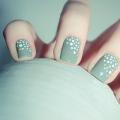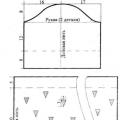Crochet, videos, lessons, master classes, models with descriptions of crochet. Master class, crochet M to crochet
Crochet - process hand made fabric or lace from threads using a crochet hook. creating not only dense, relief patterns, but also thin, openwork, reminiscent of lace fabric. Knitting patterns consist of different combinations of loops and stitches. The correct ratio is that the thickness of the hook should be almost twice the thickness of the thread. Crochet has been known for a long time. Initially it was an exclusively male craft, but gradually became a female one. Crochet is used both for making entire clothing (for example: a sweater, scarf, dress, etc.), and finishing elements of clothing (sleeves, buttons, cuffs, etc.) or decorations (napkins, curtains, etc. .). Recently, crocheting toys has been gaining popularity - amigurumi.
Do you want to learn how to crochet as quickly as possible? In this article we offer you a guide to our website for learning to crochet. We have free video lessons on this topic, free crochet patterns, as well as master classes with detailed video instructions on how to crochet this or that designer clothing model. Schemes, crochet patterns are provided detailed description, high-quality photos. You will see that knitting a new hat for yourself or a child, a scarf or even a new blouse is not so difficult. On the site, among many patterns, patterns, models, you can find both knitting for women and knitting for children and men.
For those who have never held a crochet hook in their hands and want to learn how to do it, we offer our free video course: Crochet for beginners
Crochet video tutorial sections
If you want to crochet something original, beautiful and unique, then try watching video lessons on knitting using lace techniques: Irish lace, Romanian lace, ribbon. For these knitting techniques, in addition to video lessons, we also have crochet patterns, as well as detailed master classes with photo and video materials. Take a look at our category pages and look at photos of models and patterns for inspiration.
- - Crochet various decorative ornaments for fashionable women's clothing You can crochet flowers or crochet leaves in the section.
- - A large number of options crochet watch the buttons in the video lessons on the topic of the same name.
- - We highly recommend our detailed video master classes on crocheting clothing patterns for women, children, and men.
- - For those who know how to crochet using knitting patterns, we have created a separate section of the site with patterns for blouses, jackets, cardigans and other popular types of women's knitted clothing.
- - Such popular trends and techniques of crochet as freeform and lace lace are included in separate sections on the site.
- - Crocheting with a fork is no less popular in needlework. A large number of video lessons and master classes, as well as knitting patterns, are devoted to this direction in crochet on our website.
Learn to crochet with our masters using video lessons!
Crochet- this is a type of needlework that dates back many years, but at the same time it is a fairly popular hobby in our time, because with the help of this tool it can not only give joy and peace, but also become the owner of many original gizmos for the home and interior, original clothes both for yourself and for your household. Summer ones can be called especially common, because the result obtained is delicate, weightless dresses, tunics, swimsuits, pareos, Panama hats and hats.
If you want to learn crochet for beginners, then the website will become your best assistant in mastering this type of needlework. Here you will find the most complete and comprehensive knitting master class this or that thing using a hook, they are richly illustrated, so you should not have any difficulties during the work. However, if some kind of snag appears, then the crochet video will definitely put everything in its place, and you can continue working.
The very first thing you need to do is choose a hook that fits your hand; if you are just taking your first steps in this form, then know that the hook should not be very thin - this will allow you to quickly learn the basic movements, for example, you may prefer hook No. 2 or No. 2.5. Then you need to choose the most suitable one for yourself. convenient way holding the hook - you can hold it like a pen or like a knitting needle, each of these methods is good in its own way.
Choice of yarn too important stage, you should not immediately try to master crochet blouses, this is a rather labor-intensive task, and besides, beginners are not recommended to work with acrylic, wool or viscose, as difficulties may arise during the knitting process. The best option yarn for beginners will be uniform cotton.
Initial basics of crochet for women- this is a chain air loops, if you have learned how to knit it, then consider that the first steps towards achieving mastery have already been taken. Then you will need to master knitting double crochets and half crochets, and you can get to work.
If you have ever tried to knit, then you know that for the work you will need not only a hook and yarn, but also crocheting patterns. These pictures will tell you in a simple visual form how many loops are needed, what type, and whether you need to make yarn overs. You will be able to find crochet patterns - free patterns on our website, where the best needlewomen took care of this.
As for the range of models presented at website, the number and variety of them is simply amazing. Here are examples of knitting pullovers and summer tunics, scarves and hats. Of course, not only clothes and shoes can come off the hook - on our website you will find examples of crochet with jewelry patterns, original items for the home, and excellent gifts for New Year and Easter. I would especially like to note crochet for kids- tiny clothes and booties can be called simply touching.
knitting from the center
Let's start learning knitting from the center, circular knitting. You can knit both on the front side, with lifting loops in the direction from left to right, and in turning rows: connect the row, knit the lifting loops, turn the work to the other side and knit the row, and it will be oppositely directed in relation to the knitted row.
In order for the circle (motif) to be flat and not flutter, you must follow the “Rule of the Circle”:
Crocheting round motifs and napkins from the center begins with the initial or zero row.
The initial row for a circle is cast in two ways - by winding a thread (in the diagram it is indicated by a circle with a hook inside) or by knitting a chain from a VP, connecting it into a circle (in the diagram it is simply indicated by a circle from a VP or a circle with numbers inside indicating the number chains), and the first row of stitches is knitted either by tying a ring of threads, or inside a ring of VPs connected by a connecting stitch. We dial the specified number of v.p. and close them into a ring (circle) with a connecting (blind) loop. We start the first and all subsequent rows with lifting loops, the number of which depends on the height of the row.



We must remember that the lifting loops replace the first stitch, therefore, if the motif, for example, starts with 12 stitches, then in fact after the lifting loops we knit only 11 full stitches and connect circular row into the last of the lifting loops with a connecting (blind) loop. We start the next row with lifting loops to the height of the columns of the future row. If in a row you need to knit two from each column, then in addition to the lifting loops, you need to knit another column at the base of the lifting loops of this row.
We look at the inside of the thread ring.

Each “circular row” (not to be confused with spiral knitting, see below!) has a clear beginning and end and ultimately forms a closed circle, both in knitting from the center in a circle (for example, napkins, hats, berets), and when knitting with a “pipe” - skirts, yokes and blouses, sleeves, collars, socks, mittens, mittens, etc.). The “circular row” begins with lifting loops corresponding to the height of the performed columns of this row, is knitted with all increases in accordance with the “Rule of the Circle” and ends with a CC (connecting column) made in the upper loop of the lifting loops of this row. The connecting post must be made exactly in the upper VP of the lift and the loop must be tightened well so that there is no hole.
You can knit in the round either in one direction or knit in the round in rotating rows - i.e. Having finished the row with a connecting post, make lifting loops, turn the work and knit the next row in the opposite direction to the initial row, i.e. "on the wrong side" of the work.
Each knitted row is connected into a circle with a connecting post (loop), not forgetting to climb each subsequent row with the same number of lifting loops as when knitting a straight fabric. Knowing how to correctly knit the initial row of round motifs, let’s begin to study the intricacies of knitting round products: 

Spiral knitting
If in knitting round motifs we do not make lifting loops to the next row, then we will get spiral knitting- simple knitting (for example, single crochet, single crochet or single crochet) with continuous progress in the circle, or rather, in a spiral. Thus, the basis for performing the 2nd and subsequent rows can be various columns and loops of the previous rows.
Circular spiral knitting goes only in one direction - from right to left (for left-handers - from left to right). Each row does not have a clear beginning and end. In order to know where the row ends, you need to mark the last column of the row with a marker (pin, contrasting thread). In each next row you need to change the rhythm of the increases. Having knitted the 1st row, immediately proceed to knitting the next row, performing a stitch on the 1st stitch of the previous row. The small protrusion resulting at the end of the work, equal to the height of the column, is smoothed out by making 1-2 connecting columns.
Example for knitting st.b/n.
Tie a chain of the required size to start the product and connect it into a ring with a connecting loop; insert the hook into the starting loop, pick up the thread and pull it through 2 loops at once (Fig. 1 a), b). Make a lifting loop and knit in a circle inside the ring from the vp. single crochets. Knit the last stitch in the circle into the lifting loop of this circle. Continue knitting in a spiral using single crochets (dc) or double crochets (dc). Knitting in a spiral is one almost endless row. But, like every spiral, there are also rows of turns that must be counted in order to evenly distribute the increases necessary to expand the work, that is, to give the product the required shape (Fig. 2).
So, the 2nd turn-row (a mark will help you find its beginning - a marker, pin or colored thread) start like the 1st, and to expand the circle, knit 1 chain stitch through 2 stitches, or through 1 stitch, knit 2 stitches into 1 loop of the bottom turn. Adjust the number of increments in one row by applying the work to the table surface. Distribute the increases evenly throughout one turn.
It follows from this: in order to give your product the required shape - flat, cylindrical or cap-shaped - you need to make or not make increases. To knit a flat round product, we adhere to the rhythm of increases in the “Rule of the Circle”.
For a cylindrical product, tie a chain with a length equal to the circumference of the cylinder. Close it into a ring and knit stitches of the pattern from right to left. Knitting goes along the outside, as with circular knitting knitting needles If the pattern consists of double crochets, make the 1st stitch single crochet (for a smoother transition). Continue knitting the pattern, keeping the number of stitches constant.
Knit products in the form of a cone (cap), making uniform increases less often than needed for a circle.
Polygons. Not only round items can be knitted in a spiral. Its shape can be square or 3, 5, 6 and so on - angular. Knit it all in the same way as when knitting a circle, only make increases in strictly defined places: they are located on lines running from the tops of the corners of the figure being knitted to its center.
For example: Tie 4 air loops of the chain and close them into a ring (Fig. 1, a). Then tie it with single crochets or double crochets. At 4 points separated from each other by the same number of loops, make increases, i.e. knit 3 stitches on the first loop of the base. On each subsequent turn on the loop of the 2nd of these 3 stitches, also knit 3 stitches. Do this until you finish work. 
Spiral knitting is very convenient to use when tying beads
 What nail design to choose this summer: photos of new items Manicure fashion trends summer for short
What nail design to choose this summer: photos of new items Manicure fashion trends summer for short Sew a strawberry hat for girls with your own hands
Sew a strawberry hat for girls with your own hands Who introduced the concept of physical education
Who introduced the concept of physical education